Home
Travel StoriesBig Trips On A Small Bike
Big Trips On A Small Bike: Part 3
Post Received 24 Jan 2020 Travel Date 2014
By Mark Noel
Four years had passed since my journey to the Baltic States, after which the little Suzuki languished in a corner of the garage huddled beside my dribbling Enfield Bullet. Both she and I yearned for another adventure to some distant land. Since 2010 I had evaluated other motor bicycles for long distance conveyance - the Enfield being one of them, but for the reasons I have mentioned it was deemed unsuitable. No, I would continue to ride what many considered to be a girl's bike, albeit forsaking tights and a tutu, instead bolstering my image with facial hair, a bandana and a stencilled tattoo.
To me the current fashion 'adventure bikes' are a complete mystery, having evolved into two-wheeled SUVs boasting 100+ horsepower, massive weight, umpteen ride modes, bluetooth and more buttons than sewn in my fly. Without meaning to offend the legions of posh GS owners, surely these bikes have grown beyond their projected purpose? After all, who needs to haul a pair of hard panniers the size of refrigerators and a top box resembling a tumble dryer since more capacity invites packing more stuff? Touring aboard one of these monsters must consume more fuel than is beneath Saudi Arabia and be accompanied by a forklift to resurrect it after falling in the dirt. Fortunately there are now signs of a return to sanity with a shift towards smaller models that can be piloted on a mere whiff of hydrocarbon. They are less wallet-busting too!
So, for the time being I would rekindle my romance with the GN125, ignore the shame, and together we would honeymoon to somewhere more distant and challenging than we had ever been before.
Every adventure needs a pull, a lure to some magical destination. To me it is the journey, not the bike, which is key, and the harder a place is to reach brings the greater satisfaction. I once had a mate who rode a Neolithic MZ which trailed a smoke screen that kippered anyone in his wake. His journeys from the Northern Tribal Region (Durham) were planned by choosing some random church far, far, away, towards which he would progress in an oily smog until the fume cloud halted and cloaked the spire above his nominated house of God.
Inspired by this vision I decided to embark on a journey that would lead to my standing on the northernmost point of mainland Europe. By this I do not mean the Cauldron of Tacky Tourism that is the 'Northcape Experience' sought by so many travellers, some even on motorcycles. No, my aim was to reach a geographical location that is more genuine, more remote and more interesting as we will see ...
This journey would require an increase in the luggage load, since this time I would be carrying hiking gear and extra fuel to traverse the petroleum deserts of northern Scandinavia. This was achieved by packing three Primus 1.5 litre aluminium bottles to provide an emergency ration of about 120 miles. Added to this were hiking boots, waterproofs, drink bottles, a large rucksack and bumbag, plus a compass and Garmin GPS.
This about doubled the volume I had carted to the Baltics and so a set of panniers were obviously needed. I chose Oxford soft throw-over bags as Sharon has tested for BAT. These proved perfect for the trip and I agree that their ability to expand to suit a load is ideal, with plenty of straps to secure the panniers to the bike. The only puzzle was whether the fat end should face forwards or back, but this dilemma was solved by undertaking extensive wind tunnel tests which showed that fat-forward produced the least drag and maximum aerodynamic downthrust, thus preventing wheelspin when the bike entered the transonic zone. On a high performance machine like the GN125 such factors are very important!
Believe it or not the most important addition to the bike was fitting a clock on a bracket above the handlebar instruments. I fashioned this from an analogue unit that was a freebee with the home insurance, glued into a pet food tin painted black to resemble a classic Smiths Chronometric. My Whiskas Chronometric met with the approval of our cat and proved very handy when tracking progress towards ferries, etc.
Sharon mentioned that the Oxford pannier covers are a bit naff to which I would agree. My solution was to replace these in wet weather with Mountain Warehouse branded Small Rucksack Covers which are bright yellow, elasticated and of a more sturdy waterproof fabric. My rucksack was bungeed to the rear of the bike and protected with their Medium Rucksack Cover to which I bonded a GBM oval at the rear to comply with strict Scandinavian regulations. Also I vainly hoped that this would impress them Nordic types with how far I had come.
Remaining preparations were the usual pre-flight checks, plus oil change, chain adjustment and lubrication. Tools and spares carried were the same as for my trip to the Baltics, plus a fresh set of photocopied maps. When travelling through multiple countries currency becomes a bit of a headache: how much of which denominations to take? In the end I carried Manx and Sterling Pounds, Euros, Norwegian and Swedish Krone. Of course, a debit card could draw monies when needed, although be warned that exchange rates at foreign ATMs can be abysmal.
A passage aboard the freight ship from Immingham was booked again and in mid June 2014 I set off aboard the Steam Packet to England, followed by a slow ride over the York Moors to the port. In Yorkshire I encountered my first language difficulties but in the end hand signals seemed to work. Awaiting the ship I met my fellow passengers: a Scottish tree surgeon off to work in Finland, a Swedish couple who had visited their student daughter and, interestingly, a pair who lived and worked in a campervan, touring Europe earning their living over the Internet.
Arriving in Brevik the first challenge was finding the port exit, but after 20 minutes snaking between mountains of containers I found it. There the police breathalysed all us drivers and took covert mugshots in case we should steal the $850 billion Norwegian Sovereign Wealth Fund derived from their bumper oil reserves. Feeling like a branded criminal I rushed east towards the Swedish border to seek shelter in neutral territory.

Typical campsite in Sweden where I treated myself to a cabin.
I rode around the north of Oslo, then past the scenic lakes of Vänern and Vättern, camping near the town of Örebro in central Sweden. Next day I made it north of the capital Stockholm and then rode alongside the Gulf of Bothnia on my way up through Gävle on the E4 highway. The small towns and villages in this part of Scandinavia are very pretty and it was a blessing to encounter light traffic which was very respective of motorcycles. However, you soon discover that the road signs in this part of the world accord to an unfamiliar set of rules. Particularly confusing to the Brit rider is the fact that only one route sign appears 100m before a roundabout, then with no exit signs to remind you when actually on the roundabout! The other issue which confronts you in this virtually cashless society are the card-operated filling stations: you put your card in a techno-module where you are asked in Swedish for the pump number, required octane, credit card details and your dog's maiden name. The order of these requests and the location of the module varies from forecourt to forecourt. You then have to find the pump within a time limit and fill up while the vehicle queue builds behind you. Fortunately, there is usually a charming blonde who will emerge from the kiosk and give instructions in faultless English to you the dumb foreigner.

Whiskas Chronometric and teddy mascot peruse the road ahead. What's not to like?
After three days pottering north I crossed the border into Finland at Haparanda. From there we moved onto the E75, another smooth road weaving through dense forest and scattered villages. Arriving at the town of Sodankylä I paused to explore the Old Church which is one of Finland's oldest wooden churches, having been built in 1689 to serve a congregation of mainly reindeer herding Sami-Laps. This charming building has a distinctive shingle roof and an extraordinary interior that resembles the upturned hull of a boat. On my journey I saw several more timber or 'stave' churches in a similar style.
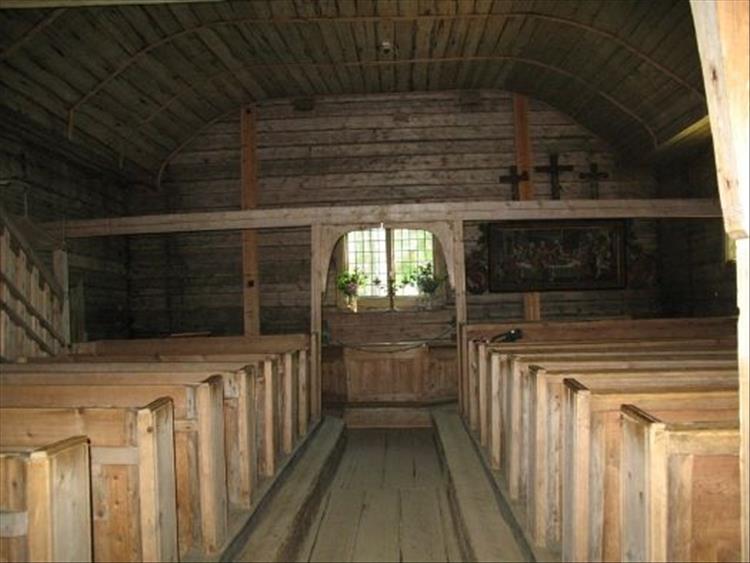
The Old Church of Sodankylä, Finland.
From Sodankylä we continued north on the E75, passing through pretty villages and then the town of Ivalo which marked my closest approach to the Russian border about 45km to the East. After another 150km I paused for two days at a campsite in the village of Utsjoki beside the Tana River, an important site for sport fishing. Most campsites in Scandinavia also have log cabins for hire, with bunks for 2 - 4 people, often with basic en-suite facilities. These provide a convenient, if expensive, refuge for the wet and weary motorcyclist and I booked one as a treat.
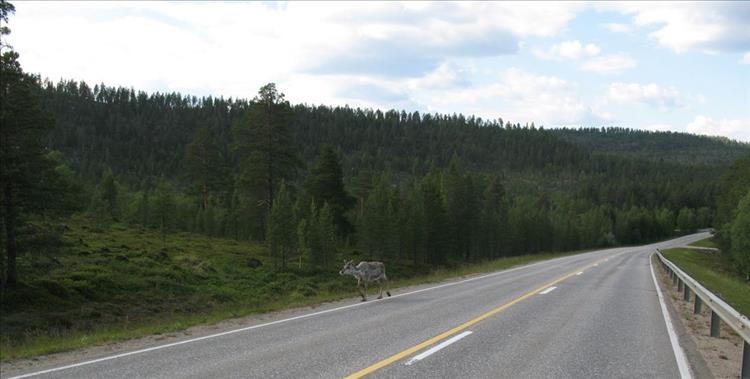
Reindeer - the main traffic hazard in northern Finland!
After recuperating and performing an oil change (my trip required 3), we crossed the Tana and entered Norway to join the E6 road which was still black-top, although of lesser quality. Over the next 120km the change in scenery was quite dramatic, with dense conifer forest gradually thinning, giving way to birch scrub, then eventually to a bare tundra landscape dotted with patches of snow. I was now hundreds of miles above the Arctic Circle in a region of permafrost and nights that remained light, the sparse vegetation being more alpine in character. I had been warned that straying reindeer are the major cause of road accidents in Northern Finland and a number of close encounters soon confirmed this! It was prudent to trickle along at 30mph when a herd was spotted in case they decided to challenge the highway code.
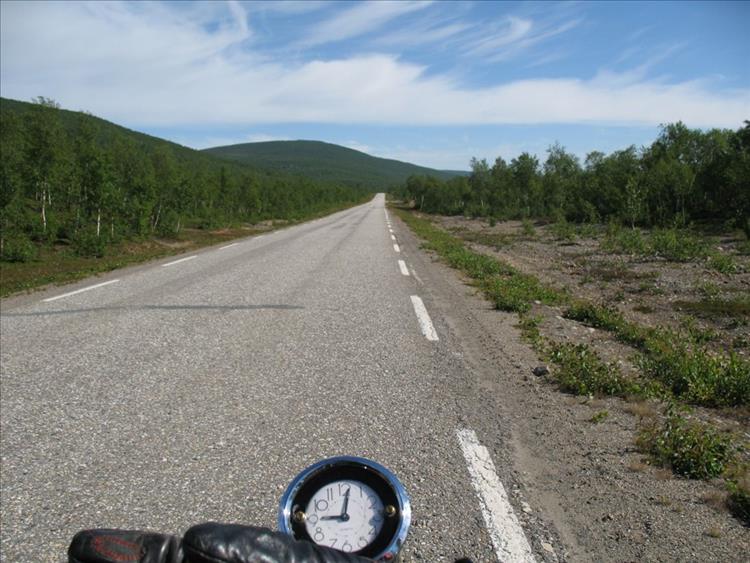
Thinning and stunted forest in northern Finland and Norway. Roads still perfect though!
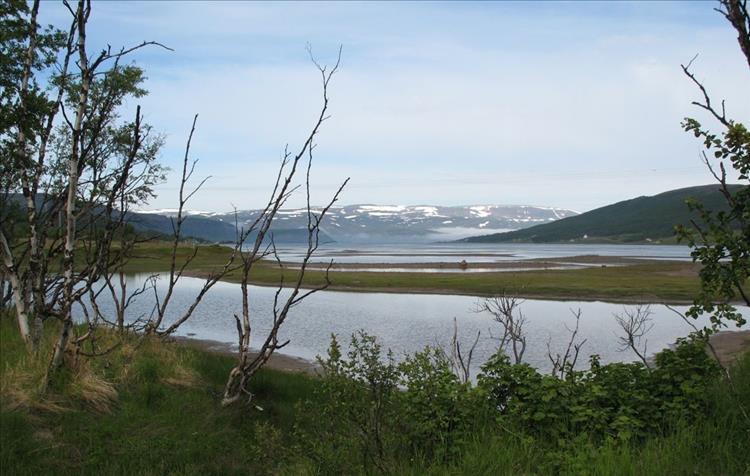
Finally there are few trees and chilly views through clear air.
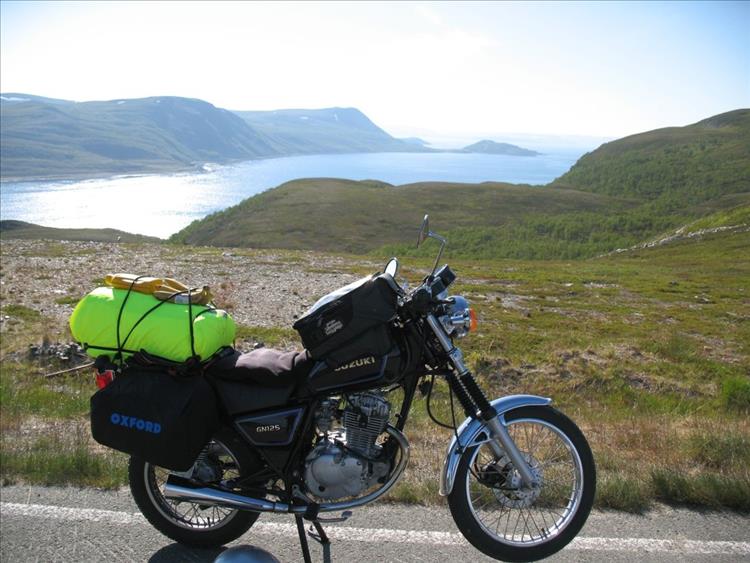
She was smiling and obviously enjoying the trip. As you can see I was fueled by bananas.
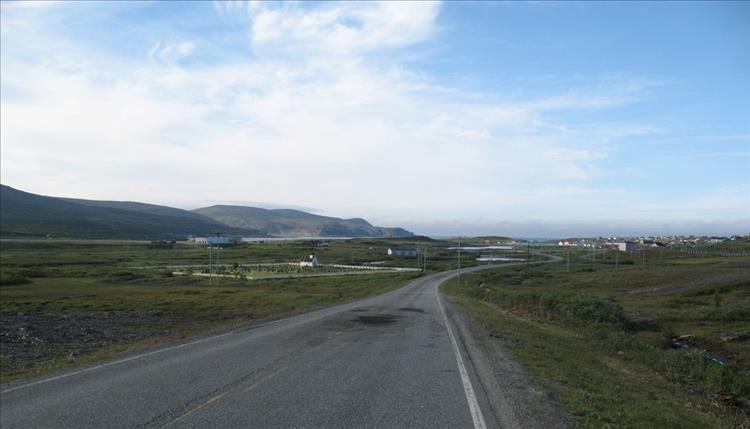
The final descent to Mehamn - just about as far north as you can ride.
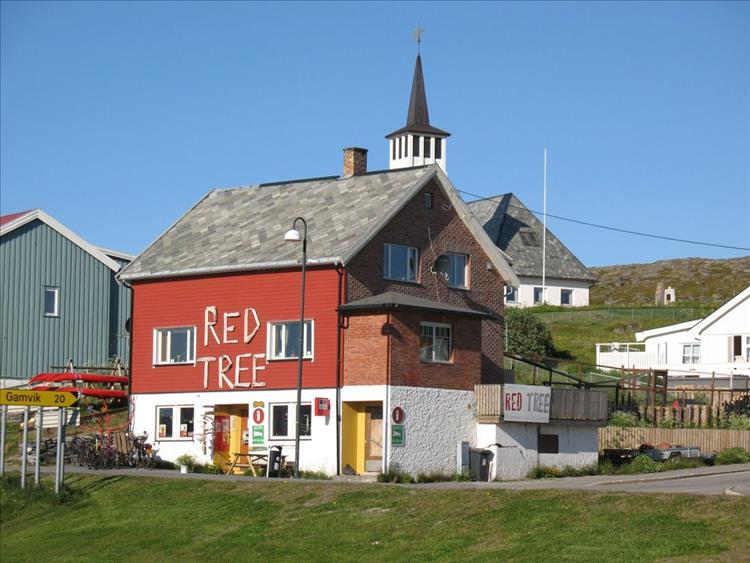
The Red Tree guest house in Mehamn.
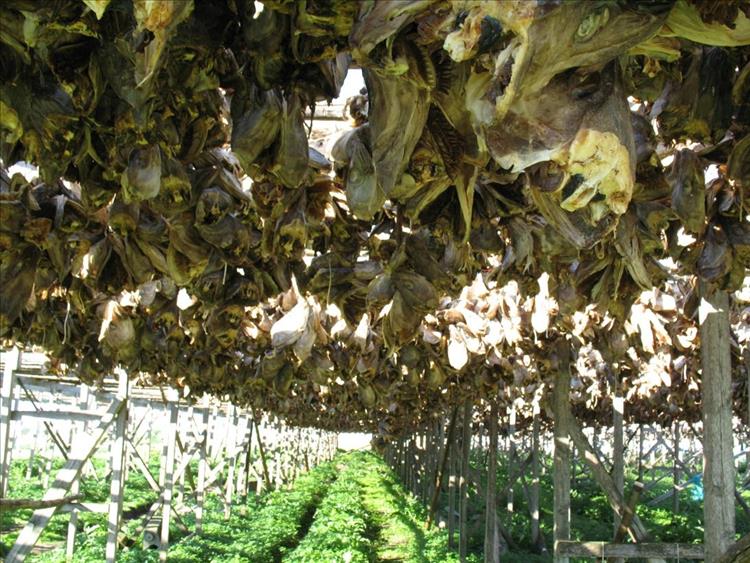
Stokfish racks for drying cod - a Norwegian delicacy (apparently).
Leaving a campsite at Tana Bru I encountered roadworks and had to ride a few miles over the only dirt of my entire trip. Finally, after a week from leaving the Isle of Man I made it along the tiny 888 road into the town of Mehamn, one of the northernmost settlements in Norway. My destination was the Red Tree guest house, a cosy refuge for hikers run by explorers Ruan and Tina. After two days feeding up with home-cooked fare I packed my rucksack and programmed my GPS with a set of coordinates provided by Ruan, in readiness for the 24km hike to Cape Nordkinn, the northernmost point in mainland Europe.
Ruan warned that this was a challenging trek, with rivers and boulder fields to cross, no maps and no cellphone coverage for use in emergency. Weather could also be very changeable. The GPS coordinates traced a route between cairns that eventually led to the Cape near which was Europe's most remote geocache for those who pursue this hobby. I left at 10a.m. to first skirt the airfield perimeter where a path passed through a portal announcing the start of this trek. In the past I have been part of several expeditions to interesting places above and below ground (e.g. Yukon, Poland, China and the Falklands) but this proved to be one of the hardest on account of the insects, snow fields and acres of boulders. Despite the challenge there were some delights: alpine flowers making the most of the short summer months, permafrost polygons and a few arctic birds darting through the heath.
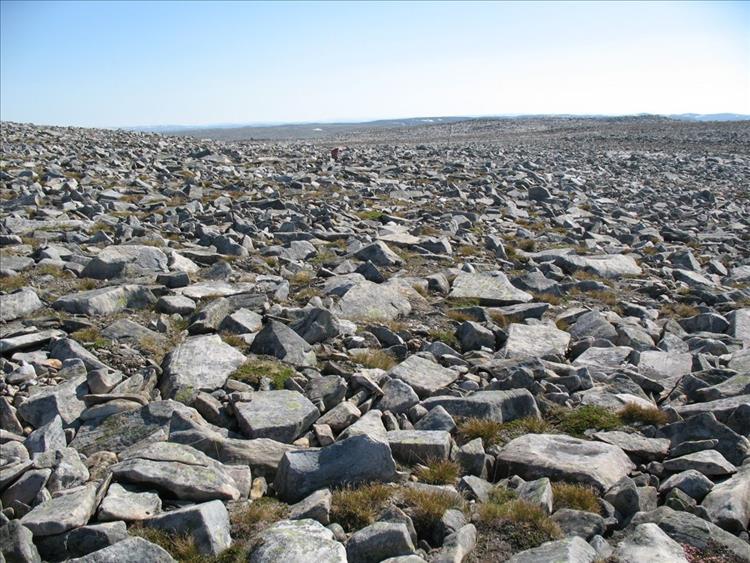
The enjoyable ramble to Cape Nordkinn!

Wildflower mini-meadows among the permafrost landscape.
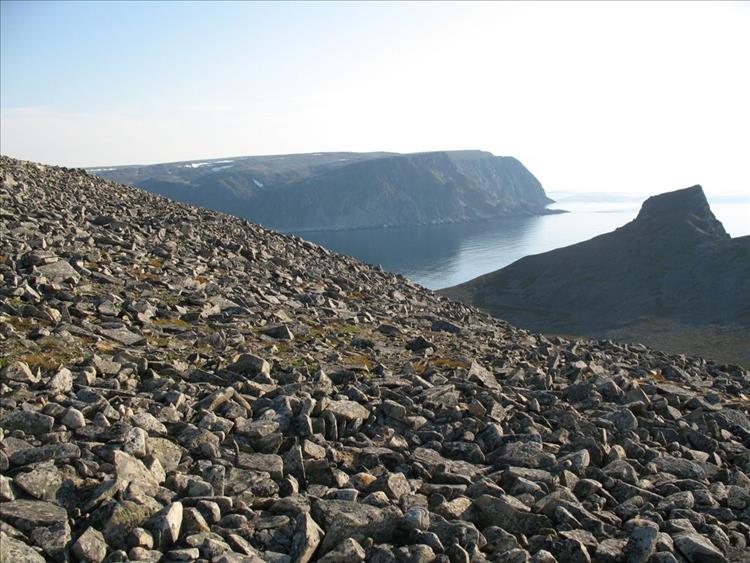
In site of my destination: Cape Nordkinn.
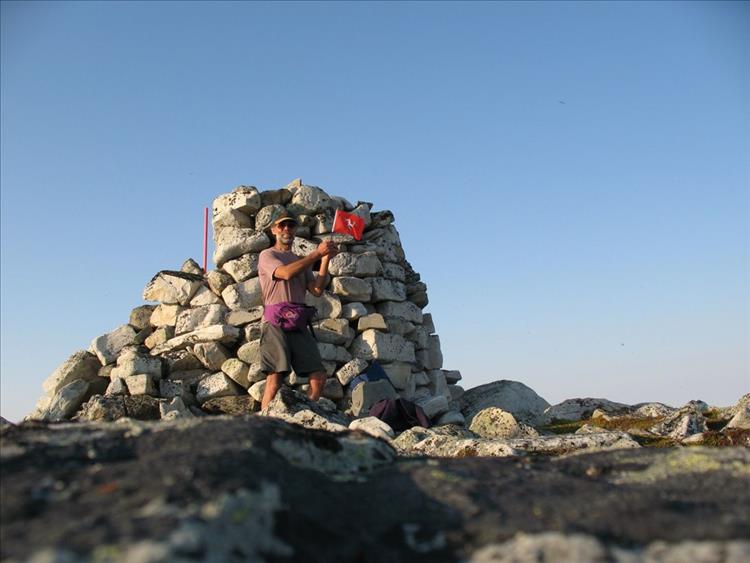
Arrived at last. You cannot go further north on solid ground!
After seven hours of ankle-busting I had my first sight of the Cape at the far side of a valley flanked by screes of unstable blocks. Down to the floor of the valley then up the other side brought me to the cairn which marked the spire of my adventure. With the Barents sea crashing on cliffs below I was for sure the most northerly person in mainland Europe. This was triumph mixed with exhaustion! That night I camped on dunes above the Bay of Nordkinn only to have the tent collapse on me during a gale. By morning a thick, chilly fog had rolled in from the Barents making it tricky to retrace my steps out of the bay. I therefore re-programmed the GPS for an alternative which took me over unfamiliar ground, and after another long trek made it back to the Red Tree with legs swollen by dozens of mozzie bites.
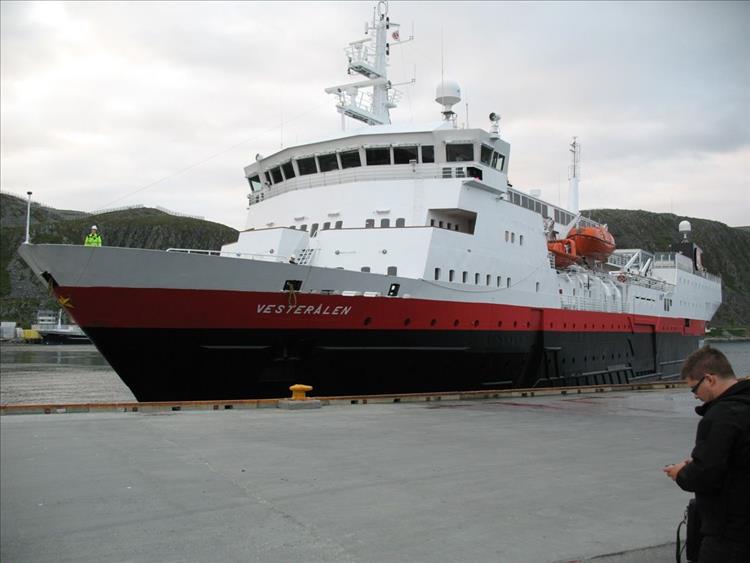
MS Vesterålen arrives for the return trip to Bergen.
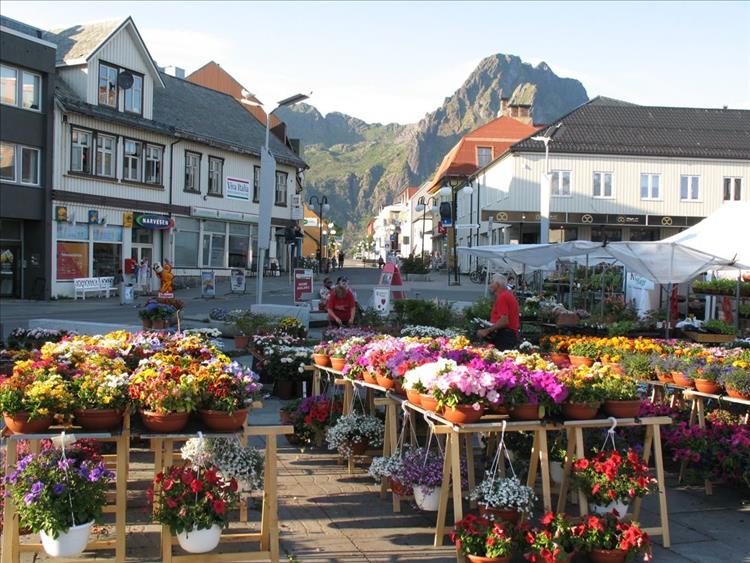
Flower market in the capital of the Lofoten Islands.
My original plan had been to ride back south to Brevik but the misery of sore inflated legs forced a change of mind. So I rode SW to the port of Kjollefjord and 'phoned the Hurtigruten to book a passage to Bergen. The MS Vesterålen arrived that evening and the next five days became another adventure as we visited countless ports on the way, the high point being our passage through the Lofoten Islands which resemble the Alps rising out of the sea. We finally disembarked at Bergen having gained several stone from feasting on smorgasbord, then rode back towards Brevik, passing though the scenic Hardanger Fjiord, feasting this time on local Morello cherries.
To my surprise I found riding in Norway to be particularly difficult: most roads I encountered were narrow and poorly surfaced and the countless tunnels proved exhausting as your eyes repeatedly switched from f32 to f4 then back again. Nearing the summit of one long climb to a tunnel entrance the GN overheated and lost power forcing me to halt for an hour while the pool of molten metal beneath the bike solidified and re-formed back into the shape of an engine. At last we reached Brevik and boarded the freight ship to begin the journey home. The rest is rather tedious and merits few words, save to say that the little Suzuki never missed a beat and made the perfect spouse for our third honeymoon.
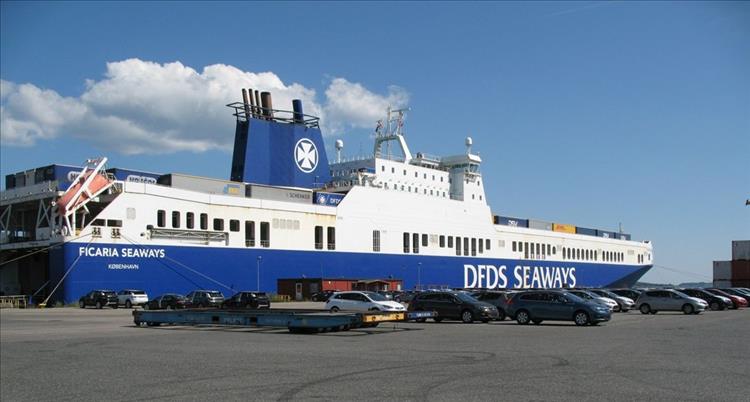
Preparing to board the freight ship for the crossing from Brevik to Immingham.
For anyone contemplating a long ride through stunning scenery, with little traffic and English spoken, then Scandinavia is a sure bet. Yes, it is very expensive to eat and sleep but the rewards are light, respectful traffic (at least in the north), and the sense that you are one of the very few in this part of the world. After all I met not a single Brit on foot, bicycle or motor vehicle on the entire trip (just one on the Hurtigruten!). Sadly the Red Tree in Mehamn has now closed but there are quality campsites throughout Scandinavia and wildcamping is permitted, subject to certain restrictions, so a big saving can be made there. Pack several gallons of insect repellant and you will be fine. Alternatively ride a smokey two stroke to keep the beasties away!
If you want to share your travel tale be if far flung or humble then click here.
Big Trips On A Small Bike: Part 1
Mark has quite an exotic history of powered 2 wheeled velocipedes when a humble 125 crosses his path. Reluctantly he takes it for a little spin to see what it's like.
Big Trips On A Small Bike: Part 2
Mark rather enjoyed his Highland trip on the Suzuki 125, so why not go just a little bit further this time? Maybe dip a toe into Europe?
Big Trips On A Small Bike: Part 3
After a 4 year rest (blimey) Mark decides the GN125 could do with another ride out. But where to go? North. Way North. Way way way North.
Reader's Comments
Snod said :-
It's nice and everything but innit a bit cold like?
17/02/2020 22:13:31 UTC
Mark Noel said :-
Snod,
Actually, no. When I was there Scandinavia was experiencing record summer temperatures, typically 20C each day. I was walking in shorts and T shirt most of the time (much to the delight of the mosquitoes), although it was very much colder at night. I had to cross several snowfields where the surface was rock hard.
This far north the ground is permanently frozen because the mean annual temperature is below zero. As a result the soil is heaved into hummocky polygons which I had read about in textbooks but never seen in life.
Trekking here in winter is a very serious proposition and would require winter-grade shorts and a much thicker T shirt. Still, it could be fun though!
18/02/2020 11:03:28 UTC
Ian Soady said :-
Great report and pics - many thanks. Sounds exhausting!
18/02/2020 11:10:21 UTC
Upt'North said :-
Gud on ya Mark. Nice write up.
Upt'North.
20/02/2020 09:22:53 UTC
nab301 said :-
A great trip and some lovely photos. It's amazing too how a change of handlebars can make a bike (GN 125) look so different!
Nigel
04/03/2020 21:29:33 UTC
Ren - The Ed¹ said :-
Mark created the "GN125 Tourer" version by changing the 'bars.
05/03/2020 09:14:30 UTC
Derick62 said :-
Brilliant read. Great idea using the cat food tin and analogue (freebie clock) one day oh yes one day I'm hoping to do something similar.
29/03/2020 09:52:01 UTC
Name
Comment
Add a RELEVANT link (not required)
Upload an image (not required) -
Uploading...
Home
Travel StoriesBig Trips On A Small Bike